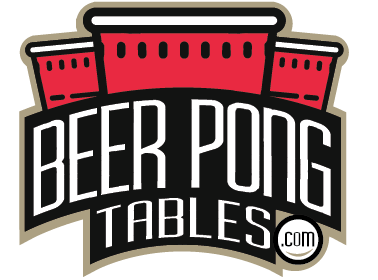Official Beer Pong Rules
Dubbed the “Great American Drinking Game”, Beer Pong’s popularity cannot be understated. You’ll find it at house parties, receptions, tailgates, and the occasional festival. It’s this popularity that has created wide variations in styles and rules, with virtually zero games being played exactly the same (outside of official tournament play...more on that later).
The rules noted below are casual play rules (or “party” rules), which means we’ve taken what are typical rules and themes and condensed them into a general format you can follow. Feel free to make up any variations you like, but just note, these rules are widely accepted and should be the base of your specific gameplay.
If you’re an experienced, hard-core player and want to follow official rules, check out the World Series of Beer Pong (WSOBP) rules to govern play. For general rules and information pertaining to casual play, read on.

What is Beer Pong?
Beer Pong is typically played on a table measuring eight feet by two feet with ten cups arranged in a triangle pattern at each end. Teams of one or two take turns throwing a ping-pong ball at the opposing team’s cups. If a shot is made (thrown directly in or bounced into a cup), the cup is removed and consumed by the opposing team. The goal is to eliminate all of your opponent’s cups before your cups. The winning team retains their right to stay and play at the table. The losers find another team to replace them, although, typically there’s a line of people ready to play. Simple right? Well, unfortunately, that’s where the simplicity ends.
Casual Rules
Before you begin a game, you’ll need to establish and get clear on the following rules. Trust us, this is important. If rules are not clear or defined before a game begins, it can lead to conflict. And no one wants to see people bro out; they want to drink, enjoy some friendly competition, and have a good time. Rules are arranged alphabetically for your convenience. You’re welcome.
- Balls Back: If you and your partner both make cups during your turn, you get to shoot again. This is referred to as “balls back” since your opponents need to remove the made cups and return them to you. You do not get to re-rack in this scenario, as this is considered a bonus or mid-turn play.
- Behind-the-Back: If you shoot, miss, and the ball remains on the table and/or is bouncing on the table, you can grab it for another shot. This shot must be performed “behind the back” and if made, counts as one cup. This shot is considered a bonus or mid-turn play (no re-racks allowed).
- Bouncing: A great way to double-up on your opponent and keep them focused on the game is by intentionally bouncing the ball while shooting. This can be off the table, ceiling, or any object. If your bounce shot is made, that cup is removed and another cup of your opponent’s choice. Having this rule in place speeds up play and makes things more exciting.
- Elbows: When you attempt to shoot the ball, your elbow must remain behind the end of the table. This prevents people from reaching and/or intentionally leaning over the table to make a shot easier. When shooting on a eight-foot table, you can imagine how close you can get by leaning. Have an unbiased party watch your opponent if this becomes a problem. If their elbow breaks the plane of the end of the table, the shot doesn’t count and must be reshot. Continual infractions should lead to a loss of turn.
- Eye-to-Eye: When a game between new opponents begins, the “eye-to-eye” rule is used to determine who goes first. For example, a player from each team shoots while looking each other in the eyes while doing so. If both cups are made, the process starts over. If team A makes a cup and team B misses, then team A goes first.
- Fingering and/or Blowing: We rarely see this in action anymore but it should be clarified. It’s best to use an example here. Let’s say you make a shot but it hasn’t quite yet settled at the bottom of the cup as it’s spinning around the edge or inside. If this rule is in place, your opponent can reach in a remove the ball with their finger or blow it out with their mouth. Seems silly, right? It is. Don’t put this rule in place. It’s really hard to determine if the ball actually has rested at the bottom of the cup and it’s really easy to finger/blow it out. People will take advantage of this rule if it’s in place, so again, don’t do it.
- Fire: If a player makes two shots in a row during separate turns, the player may call “heating up” to announce their streak. If they make a third shot on the next turn, they call “fire” and are allowed to shoot over and over again until they miss. Keep in mind that if the player does not call “heating up” at the end of their second turn, they are not eligible for “fire” and the game continues normally.
- Island: Once per game, each player may select an isolated cup (not touching any other cups) to shoot at and call “island”. If the cup is made, it’s removed and another cup of your opponent’s choice. If the cup is missed and inadvertently goes into a different cup, nothing is made and that cup remains on the table. Keep in mind that the island cup must be isolated from other cups during the normal course of play, not by other means such as sliding or not tidying up the cups.
- Overtime: A game that has proceeded to overtime uses three cups instead of the regular ten. They are arranged in a triangle at the end of each table. The team to first make all of the opponent’s cups goes first. In overtime, no re-racks are allowed. However, if requested, the last cup may be pulled back and centered at the end of the table. The same rebuttal and behind the back rules apply during overtime. Good luck.
- Redemption: If you’re lucky enough to have made all of your opponent’s cups first, the game isn’t over just yet. Your opponents now have the opportunity to totally redeem themselves by shooting at their remaining cups until they miss. At this point, the order in which they shoot doesn’t matter. Any remaining re-racks can be used at this time. If both players miss and cups still remain on the table, the game is over. If all remaining cups are made, the game proceeds to overtime (see below for rules).
- Re-racks: This refers to re-arranging cups in a specific pattern during the course of play. Typically, teams are allowed only two reracks during the start of their turn during a game. The cups can be arranged at the back of the table in a pattern of their choosing, say a diamond, straight line (“line ‘em up), or christmas tree (triangle with a two-cup base). There’s a lot of room for creativity here. But agree on how many reracks are allowed per game and acceptable patterns.
- Tidying-up: Not to be confused with re-racking, this action can be used at any time during the game to “tidy-up” or “tighten-up” cups that may have slide around and become unarranged on the table. This is pretty common during later stages of the night when a pool of beer has formed on the tabletop causing the cups to move easily. A solid cup arrangement helps keep things in order and enhance gameplay.











